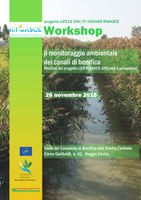Workshop "Environmental monitoring of drainage canals"
The problems and methodological difficulties of environmental monitoring of the network of drainage canals in application perspective of the Water Directive 2000/60 / EC, have been addressed in workshop organized as part of the European LIFE RINASCE Project, at the headquarters of Emilia Centrale Reclamation Consortium.
The purpose of the meeting was to identify new areas and to deepen the monitoring carried out so far in the reclamation canals, promoting and evaluating the feasibility of new experiments on pilot sites.
The event has recorded a good attendance of representatives of Territorial Bodies, Universities, Reclamation Consortia, various associations and freelance professionals.
During the work, the issues regarding the limits, the difficulties and the prospects in the monitoring of the plain clearing channels were addressed.
At the opening of the works, Dr. Domenico Turazza, Director of the Reclamation Consortium and Dr. Aronne Ruffini, Head of the Environment Area, after the greeting to the presenters, introduced the event of the day and later handed the word to Eng. Marco Monaci who summarized the LIFE RINASCE Project, illustrating the objectives, strategies and activities developed during its course.
Afterwards, the speech was passed to Prof. Daniele Galli of the "A. Zanelli" institute of Reggio Emilia, who discussed the topic of chemical-physical quality of surface water.
Following Dr. Silvia Franceschini of ARPA Reggio Emilia illustrated the activity of monitoring Macrobenthos and Dr. Anna Maria Manzieri of ARPA Modena presented the methodological and operational difficulties in sampling the community of aquatic macrophytes.
Prof. Daniele Galli then illustrated the activity of monitoring the ecological functionality of water bodies through the application of the IFF Method.
It was then the turn of Dr. William Morelli of the INCIA Society, that presented the monitoring of flora and riparian vegetation.
Dr. Giuliano Gandolfi presented the results of pre-intervention monitoring of fish fauna in some sections of the reclamation canals.
Dr. Fabio Simonazzi then presented a study on amphibians monitoring held in the drainage canals.
So it was the turn of Dr. Elisa Monterastelli who presented the monitoring of the Carabidae as indicators of the biodiversity of the riparian belt.
The presentations were then discussed with participants by sharing and comparing such experiences. The debate was chaired and conducted, by a brief presentation, by Prof. Pierluigi Viaroli member of the Department of Bio-Sciences at the University of Parma until the completion of the works.
To conclude, Prof. Luigi Sala of the University of Modena and Reggio Emilia presented the data on the ecological status of some canals studied.
|
Speaker |
|
|
Marco Monaci |
|
|
Daniele Galli |
|
|
Silvia Franceschini |
|
|
Difficulty sampling community of aquatic macrophytes (ITA) ( |
Anna Maria Manzieri |
|
Monitoring the ecological functionality of water bodies (ITA) ( |
Daniele Galli |
|
William Morelli |
|
|
Giuliano Gandolfi |
|
|
Fabio Simonazzi |
|
|
Elisa Monterastelli |
|
|
Pierluigi Viaroli |
|
|
Luigi Sala |

 Programme (
Programme (